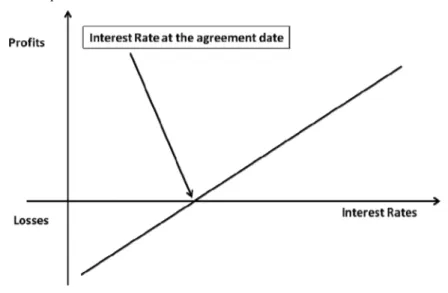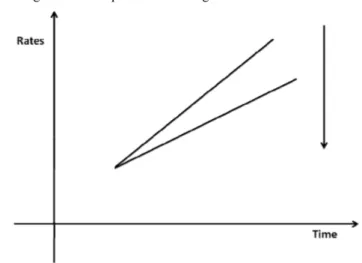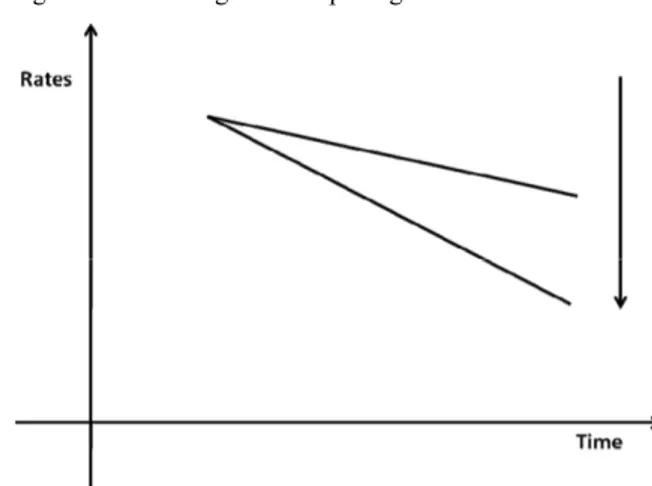Futures prices and basis risk: relationship and
strategies
Michele Patanè
Department of Business and Law, University of Siena,
Piazza San Francesco, n. 7/8, Siena, 53100, Italy
Email: [email protected]
Abstract: The assets prices in the spot markets generally diverge from those in
the futures markets. The drivers of the misalignments derive from the configurations of the rates curve and from the types of financial products traded on both markets. In particular, the prices in the futures markets are very sensitive and, following the changes of economic scenario and the new information, they readjust themselves ahead compared to the spot prices. For this reason, the analysis of the forecast of the new relationships that may set up between the prices of the two markets allows to address in a more rational manner the choice of portfolio, which is the positioning, as appropriate, in the most advantageous market. The corally for all the previous statements is the possible increasing of profits and the potential restraints of losses.
Keywords: financial futures; basis risk; strategies.
Biographical notes: Michele Patanè is an Associate Professor of Financial
Markets Economics and Interest Rate Derivatives, Department of Business and Law – University of Siena. The most recent topics of his research are related to the analysis and empirical evidence of functioning of markets, intermediaries activities and on forecasting techniques to evaluate portfolios risk of financial instruments. Further research deals with the study the study of links between macroeconomic news, monetary policy and the dynamics of volatility and prices of assets on financial markets.
1 The technical features of financial futures
The financial futures are forward agreements allowing two parties to exchange, at a future date (maturity), a specific amount of financial assets (currencies, fixed-rate bonds, short-term deposits, stock indexes etc.), at a specified price (futures price). The value of the contract changes over the time until its maturity because the future price changes during the life of the contract, due to the underlying market price changes. Upon expiration the futures price should be the same as the current price of the underlying market; if the final price (liquidation value) is above or below the initial futures price, the investors achieve, respectively, a profit or a loss. In particular, the buyer of a futures contract (long futures on fixed-rate or short-term deposits) achieves profits if the rates decrease and losses if the rates increase, because the underlying market value changes and the interest rates ones move in the opposite way. On the other hand, the seller of the
contract (short futures) will achieve a profit if the rates decrease. The market operators who have long positions on the financial futures may close them by taking opposite positions at any time and before the contract expiration date. The operators who open long or short futures positions have to deposit a collateral margin at a clearing house and in a specific percentage of the nominal value of the agreement; that margin is used to charge or credit daily losses or profits and gives to the operators a significant leverage because they can operate directly with multiple values of the financial assets. The clearing house deals directly with everyone who take long or short positions on futures; so the clearing house acts as an intermediary because it assumes the position of purchaser against each seller of futures and vice versa, guaranteeing the timely fulfilment of all agreements. If the collateral margin, before the expiration of the contract, should be below a specific limit because some losses occur, it will be compulsorily restored or reinstated to keep the original position. Otherwise, the clearing house will close the positions, on its own initiative, avoiding the occurrence of possible defaults and thus ensuring the success of the open positions.
Finally, if an investor or intermediary fear or predict interest rates decrease, they will take a long position on futures contracts. Conversely, if they fear or expect a rate hike, they will take a short position. A long position payoff in financial futures is represented in Figure 1.
Figure 1 Long position on financial future
Figure 1 shows that an increase in the interest rates, after the drafting of the agreement, implies the onset of losses on the position. On the other hand, the decrease of the interest rates implies the achievement of profits. A short position on financial futures is represented in Figure 2.
Figure 2 shows observations exactly opposite to those specified for the future long position. The financial futures offer a further opportunity for operators to manage and control the risk or the possible impact that new information may have on the market value of specific financial assets or whole portfolios. So, the operators can change their position thanks to the spot or forward markets, those where the futures are traded.
The features of the financial futures (starting margin and leverage) give them both characteristics of cheapness and operational advantage. These features suggest preferring the use of futures markets for strategies that seek to change, at a later date, the level of risk assumed earlier. This reason makes the futures markets those that are influenced first by new information which involves price adjustments in advance of the spot market prices.
Figure 2 Short position on financial future
2 Spot prices and future prices: basis strategies
Now we focus on the basis (Hull, 2014),1 so that we can take advantage of the forecasted
changes in the yield curve and it could be profitable to operate in spot markets or in the futures. The basis is the difference between the spot price and the futures price of a financial asset.2 The futures price for the forward purchase or sale of a short-term deposit
(short-term rate futures) is less than the spot price of the underlying (positive basis) if the yield curve has an upward slope. In this case, the forward rate, that is used to price and set the return (purchased future) or the cost (sold future) of the forward deposit, is higher than the spot rate to invest or borrow from today until the deposit expiration. An example is useful to better understand this way of thinking:3 let us consider a time period (0, T)
divided into two sub-periods (0, t) and (t, T). A market operator may choose to invest or borrow directly for the whole period (0, T) at a higher rate or to invest or borrow first, for the shortest period (0, t), at a lower rate, and then he decides, at time 0, to purchase a futures (forward investment starting in t and ending in T) or sell a futures (forward financing (t, T) to cover and complete the whole time period of the first choice (0, T). The two choices, at time 0, must lead to the same result; so the purchase price (investment) or sale price (financing) of the futures (for forward deposit) must be less than the spot price to balance the lower return earned by shortest interval (0, t) investors or the lower cost to those who found themselves for the same period than those who directly choose the longer period (0, T).
The futures price for the forward purchase or sale of a short-term deposit (short-term rates futures) is greater than the spot price (negative basis) if the yield curve has a downward slope. In this case, the forward rate, that is used to price and set the return (purchased futures) or the cost (sales futures) of the forward deposit, is lower than the spot rate to invest or borrow from time 0 until the deposit expiration. Reverse reasoning to that one made for positive basis is useful to better understand this way of thinking.
Also futures on bonds (medium and long-term interest rates futures), have a lower price than the cash price of the underlying (positive basis) if the yield curve has an upward slope; on the other hand, the basis is negative if the yield curve is downward. The spot price is higher than the futures price (positive basis), during the period between the spot purchase of the asset and the futures contract expiration, if the return of the spot purchase of the asset is higher than the interest cost incurred to finance the same assets. By investing immediately, the asset is more profitable than a long position on futures and meanwhile investing money at a lower rate until the future expiration. Otherwise, if the asset return is lower than the interest costs incurred to finance the purchase, the future price is higher than the spot price. So holding a long position on futures is more profitable than investing immediately in the asset, because in this way we could invest money at a higher rate until the futures expiration.
If the basis is not equal to zero (the yield curve has an upward/downward slope), it does not change if the yield curves move in a parallel manner. In this case, the spot and the futures price move in the same direction and market operators can take a position indifferently on the spot or futures market, achieving the same profits or losses. The general rule requires buying spot or future in view of interest rates decrease and selling spot or future in view of interest rates increase.
Otherwise, if the interest rates curve changes its slope, according to forecasts, the basis changes and holding a long or short position in the spot market or in the future one leads to different outcomes. In view of a slope change of the rates curve, a positive (negative) basis may increase or decrease, as appropriate (Choudhry, 2006).4
An example is useful to better understand this way of thinking. Let us consider first an increasing rates curve (upward slope): the spot price is higher than the futures price (positive basis). Then we suppose a further interest rates increase which can lead to a steeper or flatter curve, as represented in Figures 3 and 4.
In Figure 3 (steeper upward curve) the positive basis is set to increase and the spot price decreases less than the futures price. In this case, before the rate curve increases, selling financial futures lets us gain greater profits than losses that could be avoided selling on the spot market. As a result, buying on the spot market realises lower losses than those which might be incurred by purchasing futures.
In Figure 4 (flatter upward curve) the positive basis is set to decrease and the spot price decreases more than the futures price. In this case, before the rate curve increases, selling on the spot market lets us avoid greater losses than profits that could be gained selling on the futures market. As a result, buying on the futures market realises lower losses than those which might be incurred by purchasing on the spot market.
If we have a positive interest rates curve and a positive basis (the spot price is higher than the futures one), it is possible that the interest rates curve becomes steeper or flatter, as represented in Figures 5 and 6.
Figure 3 Increasing returns with positive steepening curve
Figure 4 Increasing returns with positive flattening curve
Figure 6 Decreasing returns with positive flattening curve
In Figure 5 (steeper downward curve) the positive basis is set to increase and the spot price increases more than the futures price. In this case, before the rate curve decreasing, buying on the spot market lets us gain greater profits than those achieved buying on the futures market. As a result, selling financial futures realises lower losses than the renounced profits if you sell on the spot market.
In Figure 6 (flatter downward curve) the positive basis is set to decline and the spot price increases less than the futures price. In this case, before the rate curve decreasing, buying on the futures market lets us gain greater profits than those achieved buying on the spot market. As a result, selling on the spot market realises lower lost profits than losses which might be incurred by selling on the futures market.
Definitively, strategies on the basis can be summarised in this way. In view of a steeper positive rate curve (Figures 3 and 5), the best strategy is to buy the basis (buying spot and selling futures). Otherwise, in view of a flatter positive rate curve (Figures 4 and 6), the best strategy is to sell the basis (selling spot and buying future).
Let us consider a decreasing rates curve structure (downward slope): the spot price is lower than the futures price (negative basis). Then we suppose a further interest rates increase which can lead to a steeper or flatter curve, as represented in Figures 7 and 8.
In Figure 7 (steeper upward curve) the negative basis is set to increase and the spot price decreases more than the futures price. In this case, before the rate curve increases, selling on the spot market lets us avoid greater losses than the profits that could be achieved selling on the futures market. As a result, buying financial futures realised lower losses than those which might be incurred by purchasing on the spot market.
In Figure 8 (flatter upward curve) the negative basis is set to decrease and the spot price decreases less than the futures price.
In this case, before the rate curve increases, selling financial futures lets us realise greater profits than the losses that might be avoided by selling on the spot market. As a result, buying on the spot market realises lower losses than those which might be incurred by purchasing on the futures market.
Figure 7 Increasing returns with negative steepening curve
Figure 8 Increasing returns with negative flattening curve
If we have a negative interest rates curve and a negative basis (the spot price is lower than the futures one), it is possible that the interest rates curve becomes steeper or flatter, as represented in Figures 9 and 10.
In Figure 9 (steeper downward curve) the negative basis is set to increase and the spot price increases less than the futures price. In this case, before the curve decreases, buying on the futures market lets us realise greater profits than those achieved by purchasing on the spot market. As a result, selling on the spot market leads to lower lost profits than losses which might be incurred by selling on the futures market.
In Figure 10 (flatter downward curve) the negative basis is set to decrease and the spot price is higher than the futures price. In this case, before the curve decreasing, buying on the spot market lets us gain greater profit than those achieved by purchasing futures, as a result, selling on the futures market realised lower losses than the renounced profits if you sell on the spot market. Definitively, strategies on the basis can be summarised in this way. In view of a steeper negative rate curve (Figures 7 and 9), the best strategy is to sell the basis (selling spot and buying futures). Otherwise, in view of a flatter negative rate curve (Figures 8 and 10), the best strategy is to buy the basis (buying spot and selling future).
Figure 9 Decreasing returns with negative steepening curve
Figure 10 Decreasing returns with negative flattening curve
3 Conclusion
This analysis shows that the yield curve might change its original slope and so the link between the spot prices and the futures prices changes. When a change of the basis is forecasted, holding a long/short position on the spot market or on the futures could be attractive or unsuitable depending on the slope movements. Studying carefully the next dynamic of the basis allows us to achieve more profits or to limit the possible losses.
References
Choudhry, M. (2006) The Futures Bond Basis, John Wiley & Sons Ltd, England. Hull, J. (2014) Fundamentals of Futures and Options Markets, Pearson, Australia.
Notes
1See Hull (2014).
2We hypothesised that theoretical basis is equal to real one. The two kinds of basis could differ
because of market imperfections, option delivery value and transaction costs.
3In this case yield curve is based on rational expectations theory and long-term rates do not include
liquidity premium.





